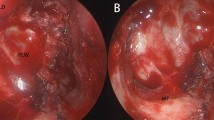Abstract
The lateral rhinotomy approach is one of the most commonly used techniques for exploration of the difficult sinonasal masses. Though endoscopic advances have progressed rapidly since last few years, but the excellent exposure provided by the lateral rhinotomy approach makes it suitable for resection of sinonasal masses with extensive spread. Our study is an attempt to establish the different spectra of pathologies encountered in the sinonasal region, which were removed by the lateral rhinotomy approach and to establish its importance in the context of modern rhinological surgeries.
Similar content being viewed by others
References
Watkinson JC, Gaze MN, Wilson JA (2000) Tumours of the nose and sinuses. Stell and Maran’s Head and Neck Surgery, 4thedition. Butterworth-Heinemann, Oxford Pp. 377–396
Bhatia ML, Mishra SC, Prakash J (1967) Lateral extension of Nasopharyngeal Angiofibroma. J Laryngol Otol 81:89
Gupta OP and Gupta SK (1971) Radiological investigation in extrapharyngeal extension of nasopharyngeal angiofibroma. J Laryngol Otol 85:827
De SK, Das S, De D (1987) Multiple Extranasopharyngeal extensions of Juvenile Nasopharyngeal Angiofibroma. The Journal of Laryngology and Otology 101:1083–1087
Briant TDR, Fitzpatrick PJ, Berman J (1978) Nasopharyngeal Angiofibroma: A twenty year study. Laryngoscope 88: 1247–1251
Bremer JW, Neel RB (1986) Angiofibroma: Treatment trends in 150 patients during 40 years. Laryngoscope 96:1328–1329
Mehra YN, Mann SBS, Dubey SP, Suri S (1989) Computed tomography for determining pathways of extension and staging and treatment system for Juvenile Nasopharyngeal Angiofibroma. Ear, Nose and Throat Journal 68:577–589
Catalano PJ, Brandwein M, Shah DK, Urken ML, Lawson W, Biller HF (1996) Sinonasal Hemangiopericytomas: A clinicopathologic and immunohistochemical study of 7 cases. Head Neck 18:42–53
Bruce M Weing et al. Aggressive Psammomatoid ossifyingfibroma of the sinu-nasal region-A clinicopathological study of distinct group of fibro-osseous lesion. Cancer. Vol 76, no 7
Fu YS, Perzin KH (1978) Non epithelial tumours of the nasal cavity, paranasal sinus and nasopharynx: A clinicopathological study. Cancer 33:1289–1305
Damjanov I, Maenza RM, Synder GG, Ruiz JW, Toomey JM (1978) Juvenile ossifying fibroma: An ultrastructural study. Cancer 42: 2668–2674
Lyngdoh Nicola C, Ibohal TH, Marak IC (2006) A study on the clinical profile and management of inverted papilloma. Indian J Otolaryngol Head Neck Surg 58:41–45
Klintenberg C (1984) Adenocarcinoma of the ethmoid sinuses. Cancer 54:482
Cawte T, Taskin M, Kacker A, Wahl S (1997) low grade adenocarcinoma of nasal passages. Otolaryngol Head Neck Surg 117:116–119
Batsakis JG (1979) Tumours of the head and neck. Clinical and pathological considerations. ed 2. Baltimore, Williams and Wilkins. 313–324
Stevens DJ, Kirkham N (1988) Neurofibromas of the paranasal sinuses. The Journal of Laryngology and Otology 102: 256–259
Perzin KH, Panyu H (1982) Non epithelial tumours of the nasal cavity, paranasal sinus and nasopharynx: A clinicopathological study. Cancer 50:2193–2202
Delank KW, Franzen W, Huttenbrink KB, Stoll W (1994) Long term results of lateral rhinotomy with medial maxillo-ethmoidectomy. Laryngorhinootologie 73(5): 270–273
Hussain A, Hulmi OJ, Murray DP (2002) Lateral Rhinotomy through nasal aesthetic subunits-Improved cosmetic outcome. J Laryngol Otol 116(9):703–706
Lueg EA, Jonathon C, Roth Y, Brown DH, Witterick IJ, Chapnik JS, Gullane PJ (1998) An Objective Analysis of the impact of Lateral Rhinotomy and Medial Maxillectomy on Nasal Airway function. Laryngoscope 108(9): 1320–1324
Author information
Authors and Affiliations
Corresponding author
Rights and permissions
About this article
Cite this article
Das, S., Banerjee, P., Das, A. et al. Lateral rhinotomy — revisited. Indian J Otolaryngol Head Neck S 59, 215–220 (2007). https://doi.org/10.1007/s12070-007-0064-8
Published:
Issue Date:
DOI: https://doi.org/10.1007/s12070-007-0064-8




